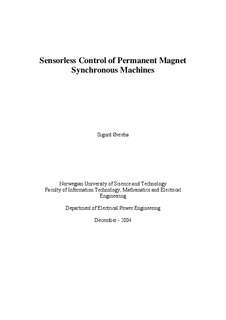| dc.contributor.author | Øvrebø, Sigurd | nb_NO |
| dc.date.accessioned | 2014-12-19T13:50:37Z | |
| dc.date.available | 2014-12-19T13:50:37Z | |
| dc.date.created | 2008-01-31 | nb_NO |
| dc.date.issued | 2004 | nb_NO |
| dc.identifier | 123146 | nb_NO |
| dc.identifier.isbn | 82-471-6522-8 | nb_NO |
| dc.identifier.uri | http://hdl.handle.net/11250/256404 | |
| dc.description.abstract | As the cost for permanent magnets are decreasing and the quality of the magnets are increasing the Permanent Magnet Synchronous Machine (PMSM) are becoming more popular. The PMSM is superior to induction machines both in torque per kilograms and efficiency. Typical applications for these machines are applications where machine volume or efficiency is important. In order to control a PMSM the rotor position needs to be known. This can be obtained by usage of sensor or by usage of a sensorless control scheme. Sensorless Control schemes typically divide into two categories; schemes that give good controllability from 2-5 Hz and schemes that gives good controllability at all speeds including zero speed. The focus for this thesis is sensorless control schemes with good controllability at low and zero speeds. Sensorless control is a multi physics challenge where the machine, inverter and control scheme are equally important for the quality of the drive system. In order to describe the saliency in the machine a new saliency machine model is developed in this thesis. The model includes yoke saturation, teeth saturation and induced currents in magnets. In injection based sensorless control the high frequency flux distribution in the machine is of great interest. In this thesis the frequency dependency in inductance is estimated in two machines by using injection of test signals in a large frequency range. Based on the measurements and the new saliency model the high frequency flux distribution is estimated and the frequency dependency of the saliency is described. A variety of different sensorless schemes are published over the last two decades. As the publications uses different test criteria it is challenging to determine the characteristics for the different schemes: three different control schemes are evaluated in terms of determining the scheme characteristics. A new scheme based on [1, 7] is presented in this thesis. The new scheme enables integration of transient excitation and position estimation in every switching period. The continuous injection based schemes evaluated in this work is rotating high frequency carrier injection [2,13,39] and pulsating high frequency carrier injection [3,26]. The different schemes sensitivity to the inverter non linearity is modelled and evaluated. A comparison of the three schemes is presented. Surface mounted PMSM typically has a small saliency. The saliency in a surface mounted PMSM can be increased in several ways. The last part of this thesis presents a redesign approach for an axial flux PMSM. Several approaches are evaluated in terms of synergy effects with the machine cost and performance. An approach based on insertion of semi-magnetic slot wedges are realised in a prototype. | nb_NO |
| dc.language | eng | nb_NO |
| dc.publisher | Fakultet for informasjonsteknologi, matematikk og elektroteknikk | nb_NO |
| dc.relation.ispartofseries | Doktoravhandlinger ved NTNU, 1503-8181; 2004:147 | nb_NO |
| dc.title | Sensorless Control of Permanent Magnet Synchronous Machines | nb_NO |
| dc.type | Doctoral thesis | nb_NO |
| dc.contributor.department | Norges teknisk-naturvitenskapelige universitet, Fakultet for informasjonsteknologi, matematikk og elektroteknikk, Institutt for elkraftteknikk | nb_NO |
| dc.description.degree | dr.ing. | nb_NO |
| dc.description.degree | dr.ing. | en_GB |
